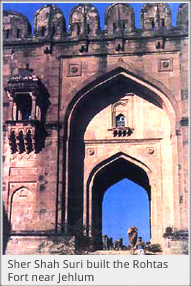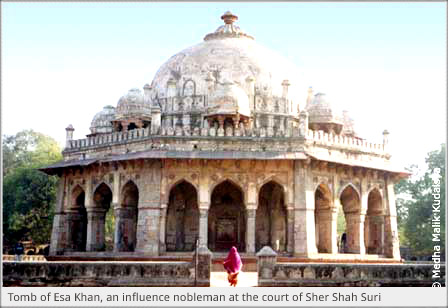Sher Khan, known as Sher Shah Suri, was an Afghan leader who took over the Mughal Empire after defeating Humayun in 1540. Sher Shah occupied the throne of Delhi for not more than five years, but his reign proved to be a landmark in the Sub-continent. He formulated a sound imperial administration that was inspired by the Safavid regime in Iran. Sher Shah employed a powerful army, which is said to have comprised of 150,000 horses, 250,000 foot-soldiers and 5,000 elephants. He personally inspected, appointed and paid the soldiers, thus making him the focus of loyalty and subduing the jealousies between clans and tribes. To prevent fraud, he revived the tradition of branding horses, introduced first by Alauddin Khalji.
 The principal reforms for which Sher Shah is remembered are those connected with revenue administration. He set up a revenue collection system based on the measurement of land. Justice was provided to the common man. Numerous civil works were carried out during his short reign; planting of trees, wells and building of Sarai (inns) for travelers was done. Roads were laid; it was under his rule that the Grand Trunk road from Delhi to Kabul was built. The currency was also changed to finely minted silver coins called Dam.
The principal reforms for which Sher Shah is remembered are those connected with revenue administration. He set up a revenue collection system based on the measurement of land. Justice was provided to the common man. Numerous civil works were carried out during his short reign; planting of trees, wells and building of Sarai (inns) for travelers was done. Roads were laid; it was under his rule that the Grand Trunk road from Delhi to Kabul was built. The currency was also changed to finely minted silver coins called Dam.
During his lifetime, Sher Shah commissioned the construction of tombs for his father, Hasan Khan Suri and for himself. A third one was begun for his son Islam, but remained unfinished due to the dynasty’s fall. Sher Shah died in 1545 by a gunpowder explosion and left his kingdom to his two sons and grandsons. Unfortunately, his successors were incompetent and succumbed to old Afghan rivalries. This resulted in the downfall of the Suri Dynasty.

This article was last updated on Sunday, June 01, 2003






